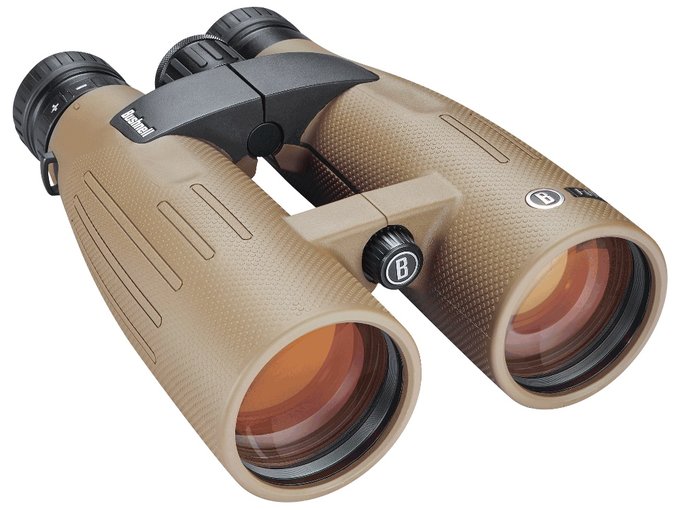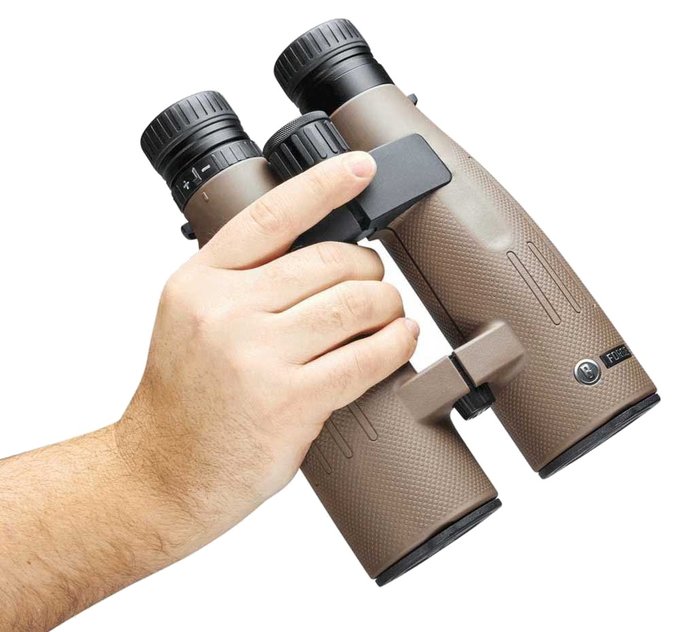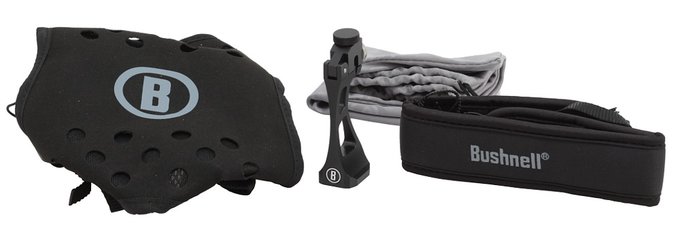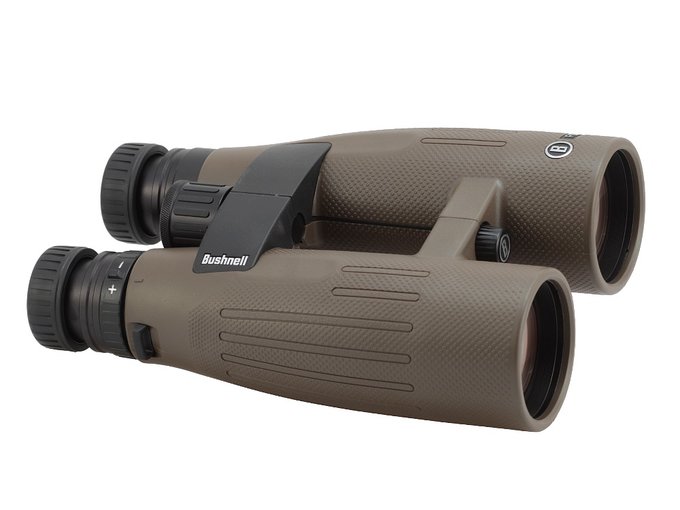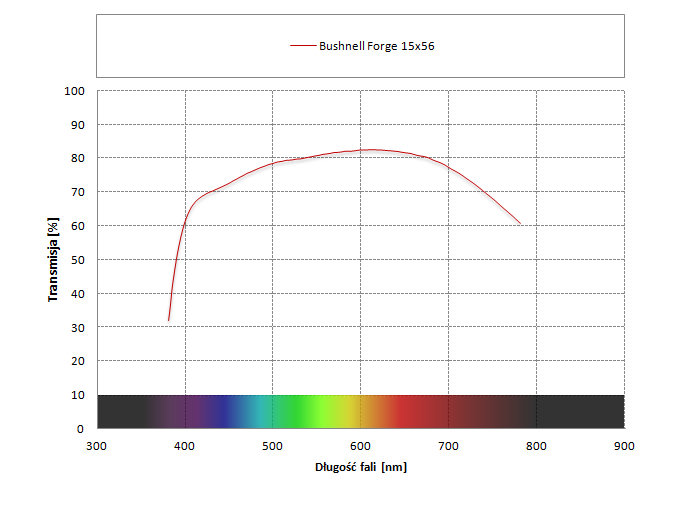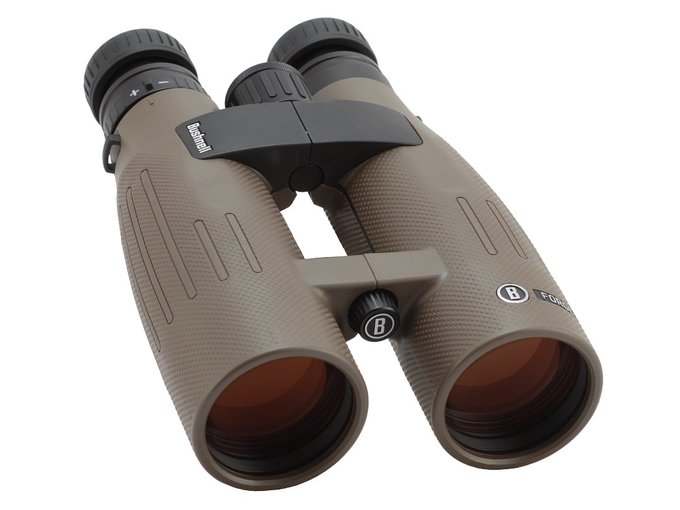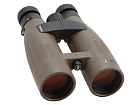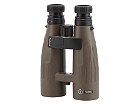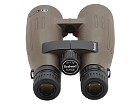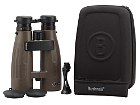In 2018 the Bushnell company remade their binoculars line-up almost completely and the Forge series was one of the novelties, presented at that time. It consisted of four roof prism models with the following parameters: 10x30, 8x42, 10x42 and 15x56.
Smaller Forge series binoculars feature Schmidt-Pechan prisms but the big 15×56 model, designed to be used in more difficult lighting conditions, was based on roof Abbe-Koenig prisms. They use the effect of total internal reflection and don't need any additional reflective coatings on any of their surfaces. Still, in this pair of binoculars the prisms are PC-3 phase coated and they also feature antireflection multi-coatings. Producers also emphasize the fact that all air-to-glass surfaces are coated by high quality FMC layers (Fully Multi-Coated). In the optical path you find low dispersion ED glass.
The barrel of the binoculars is compliant with the IPX7 standard (can be immersed into water in the depth of 1 meter at the maximum and for up to 30 minutes) and is nitrogen purged. The outer elements are covered by EXO Barrier Protection, to repell moisture and dust and also prevent scratches.
Buyers get a really rich accessory kit. In the box, apart from the binoculars, you can find a hard case, a padded strap, protective caps for all outer elements, a cleaning cloth, a tripod mount and a set of Allen keys. The binoculars come with a 15-year warranty of the producer.
| Magnification |
Lens diameter |
Angular field of view |
Prisms |
Eye relief |
Weight |
Price |
| 15 |
56 |
78/1000(4.5o) |
BaK-4/roof |
21 mm |
1455 g |
2999 PLN |
|
|
| Real front lens diameter |
Left: 56+/-
0.05 mm
Right: 55.97+/-
0.05 mm
|
8 / 8.0 pkt |
| Real magnification |
15.22+/-
0.05x
|
3/3.0 |
| Transmission |
80.2+/-
1%
|
10/25.0 |
| Chromatic aberration |
Low in the middle, near medium on the edges. |
6.8/10.0 |
| Astigmatism |
Noticeable. It is difficult to focus so the stars become perfectly point-like. |
5/10.0 |
| Distortion |
Distance of the first curved line from the field of view centre compared to the field of view radius: 45% ± 4%. |
5/10.0 |
| Coma |
Starts already at 75% of field of view and is on a borderline between medium and high values on the very edge. |
6.5/10.0 |
| Blurring at the edge of the FOV |
Blur occurs in a distance of 73% ± 3% from the field of view centre. |
4/10.0 |
| Darkening at the edge the FOV |
Practically imperceptible. |
4.5/5.0 |
| Whiteness of the image |
Distinct loss of blue and purple light – slight yellow-orange colouring. |
3.7/5.0 |
| Collimation |
Perfect. |
5/5.0 |
| Internal reflections |
| Left: |
Right:
|
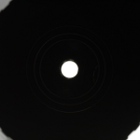 |
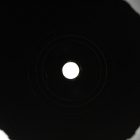 |
Very nice! Pupils against a practically black background. We docked some points for noticeable sparks on lanterns at night. |
4/5.0 |
| Housing |
A long and big open hinge construction but, because of that, comfortable to hold and to look through. Objective lenses hidden in the casing over 1 cm deep. Comfortable thumb indents help with the handling as well. Good quality rubber armour, matt and rough which sticks out near objectives a bit. Comfortable, rubber, twist-up eyecups with 3 detention stops. Produced in China.
|
7.5/8.0 |
| Focusing |
Big, comfortable, rubberized and ribbed central wheel. Its full turn takes an angle of 420 degrees. It moves smoothly and is well damped, without any squelching. Individual focusing on the right eyepiece in a form of a movable ring with distinct ribs. It moves the outer element.
|
4.5/5.0 |
| Tripod |
There is a comfortable exit but at the front of the instrument, far from the gravity centre. |
2/3.0 |
| Interpupilary distance |
from 57 to 76mm
|
5/6.0 |
| Closest focusing distance |
3.65 meters. |
2/2.0 |
| Eyepieces FOV |
Apparent field of view of 67.3 degrees (according to simplified formula) and 60.9 degrees (according to tangent formula). |
14.5/20.0 |
| Field of view |
Measured by us amounted to 4.42 +/- 0.04 degrees and was just slightly narrower than stated in official specifications. A wide field for this class of equipment. |
7/8.0 |
| Quality of the interior of the barrels |
Interior of tubes is dark, matted and ribbed. A clearly accented aperture visible several centimeters deep. Dark bottom but could have been even darker. Clean. |
4.7/5.0 |
| Vignetting |
| Left: |
Right:
|
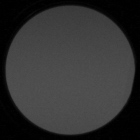 |
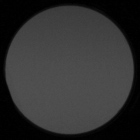 |
OL: 0.50%, OR: 0.68%. |
7/8.0 |
| Prisms quality |
Good quality BaK-4. |
8/8.0 |
| Antireflection coatings |
Pink on objectives, purple-green on prisms, purple-pink-yellow on eyepieces. Medium intensity. |
4.5/5.0 |
| Warranty [years] |
15 years |
5/6.0 |
| Final result |
72.2%
|
137.2 / 190 pkt
|
| Econo result |
|
0pkt. |
Summary
Pros:
very solid barrel made of high quality materials,
wide field of view,
good quality prisms made of BaK-4 glass,
round exit pupils against a very dark background,
practically imperceptible brightness loss on the edge of the field of view,
very nicely blackened interiors of the tubes.
Cons:
- too low transmission level for Abbe-Koenig prisms.
I admit freely, my expectations, concerning this pair of binoculars were high. After an excellent performance of the
smaller 8x42 model from the same series in our test I thought that the Bushnell Forge 15×56, a device with Abbe-Koenig prisms, was bound to fare even better.
To my surprise the binoculars didn't perform as well as I thought it would, and what's worse, the instrument failed in the least expected area. Abbe-Koenig prisms are based on the effect of total internal reflections so, when it comes to guaranteeing high transmission of the whole instrument, their task is supposed to be easier than the task of Schmidt-Pechan prisms. Meanwhile the transmission graph of the Forge 15×56 not only looks average but is even worse than graphs of smaller models equipped with prisms that can generate losses of light. Really, it's hard to comprehend how Bushnell constructors let it happen. A big pair of binoculars, with big objective lenses, is usually bought for observations in weak lighting conditions when every additional photon counts. In this class of equippment a transmission result of 80% is simply unacceptable. What's more, we really don't like the loss of blue and purple light, influencing significantly colouring of images.
Still, apart from transmission we didn't notice any serious slip-ups. However, it must be noticed that in our test the binoculars had too many medium results for our liking. That fact is reflected in their final score which, instead of being higher than in the case of the 8×42 model, is distinctly lower. Mind you, the price of the Forge 15×56 reaches 700 Euro, so is almost two times higher than the amount of money have to pay for the 8×42 and 10×42 models.
In order to do justice to the Bushnell Forge 15×56 you have to add that the producers really took proper care of its build quality. The casing we found really stylish and solid, without one bit of shoddy workmanship. Prisms are big and they don't vignette. Interior of the tubes is properly blackened and clean.
We want to state it loud and clear: the Forge 15×56 is a very good pair of binoculars and our complains mainly stem from our high hopes and expectations which, unfortunately, weren't met and the fact that the 8×42 model set the standards really high.
To sum up, I would recommend the 42 mm Forge models without compunction – they deserve it as they are very good pairs of binoculars, well-put-together, and with excellent price/performance ratio. Still, I cannot say the same about the more expensive 15×56 model which let me down exactly in the area where it was expected to fare exceedingly well.
